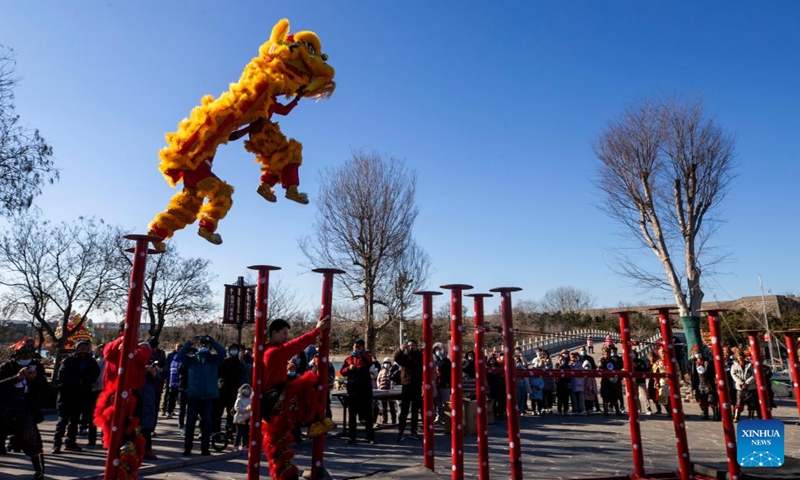
Tourists watch lion dance performance during the New Year holiday at Penglai Pavilion scenic area of Yantai, east China's Shandong Province, Jan. 2, 2022.Photo:Xinhua
The domestic tourism industry in 2022 is expected to recover to 70 percent of the pre-pandemic level, and the number of trips made in China is estimated to grow 16 percent to 3.98 billion from last year, an industry report said, with domestic tourism players cautiously optimistic on the outlook despite lingering uncertainty caused by the COVID-19 pandemic.
Hu Yongjun, an official from the China Tourism Academy (CTA), said at an industry forum on Monday that in 2022, the revenue of domestic tourism is likely to total 3.8 trillion yuan ($600 billion), up 27 percent year-on-year.
The number of inbound and outbound tourists in 2022 is expected to grow 20 percent year-on-year, recovering to 20 percent of the 2019 level.
Hu noted that in 2022, if the pandemic is brought under control, the outbound tourism market might recover, and countries along the Belt and Road Initiative, such as Southeast Asia countries and Europe,
will become the top priorities.
Han Yuanjun, a deputy researcher from the CTA, said that during the 2021-22 winter season, China's snow tourism revenues are expected to reach 323.3 billion yuan, with snow-related sports tourists reaching 300.5 million, which is likely to bring the country's aim of having 300 million people engaged in winter sports become a reality.
Song Ding, a research fellow at the Shenzhen-based China Development Institute, told the Global Times that due to the spread of the Omicron virus variant across the world, in the first half of 2022, China's tourism sector may continue to struggle with sporadic flare-ups. But in the second half of the year, the sector will make a rapid recovery.
"In 2022, China's snow-related sports tourists, boosted by the Beijing 2022 Winter Olympic Games, will help the domestic tourism sector recover to 70 percent of 2019 levels in the second half of the year, with the government's determination to control the pandemic," Song said.
According to a survey released by the CTA, the Olympic Games have ignited public interest in snow tourism, with 90.1 percent of the respondents having participated in snow sports.
A teacher surnamed Wang based in Nanjing, East China's Jiangsu Province, told the Global Times on Sunday that she is willing to experience snow sports in the city this year, as she has never gone to ski fields or snow resorts.
In the past two years, China's tourism sector has experienced unprecedented challenges and the longest recovery. Hu noted that in the first half of 2021, the sector exceeded the levels before the epidemic, but affected by sporadic flare-ups, the industry saw a decline in the second half of last year.
"Despite sporadic flare-ups of COVID-19 in 2021, China's tourism made a stable recovery due to significant improvement in the country's ability to prevent and control the epidemic," Song said.
According to Hu, in 2021, the number of domestic tourists is expected to reach 3.431 billion with revenue of 3.02 trillion yuan, up 19 percent and 35 percent respectively compared with last year.
The revenue of international tourism will post a year-on-year increase of 23 percent to $20.8 billion.
Sun Yunlei, an official from Mafengwo, a major Chinese travel platform, said in a note sent to the Global Times that in 2021, the domestic tourism market showed new potential. Remote sites with fewer visitors became top choices, and red tourism as well as winter tourism boosted local economies.
Wu Yuhan, a researcher from the CTA, said that due to recent flare-ups of COVID-19 and snowy weather, during the three-day New Year holiday, the per capita consumption of over 1,000 yuan was down 20.8 percent year-on-year.




